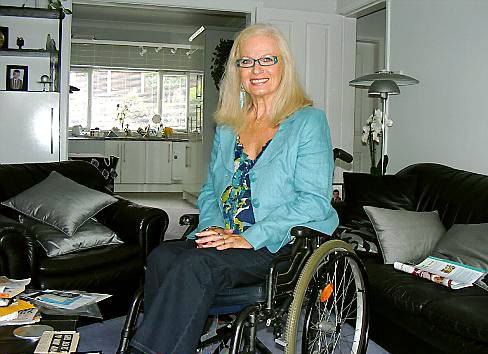The pain the scars, the legacy of polio
Reporter: LEWIS JONES
Date published: 18 October 2010

TODAY . . . polio sufferer Gill Lees now uses a wheelchair when she leaves her home
Saddleworth people came out in force recently to back a bulb planting record attempt by the Saddleworth Rotary Club and raise awareness of the worldwide campaign to eradicate polio.
While images of Third-World countries may spring to mind, it is all too easy to forget the people in Britain who suffered from the debilitating disease.Gill Lees, one of the last polio sufferers in the UK, spoke to LEWIS JONES about her experience.
ON March 11, 1957, 12-year-old Gill slumped into the back of her dad’s second-hand Jaguar, her mother holding her hand with a shining smile that she hadn’t shown in months.
Two full-length callipers and a rigid steel corset were in the boot as the car pulled away from the Monsall Fever Hospital in Manchester, but that did not matter, Gill was happy to be finally heading home to Coppice with her family.
As rumours of a polio vaccine were becoming a reality, the young sufferer thought back to the crisp November morning the year before when her adventure with friends to collect bonfire wood was cut short.
“I felt sick, my throat was sore and every part of me was hurting. I started to ache, I couldn’t stand up and my legs just crumbled,” says Gill.
After fears it may have been Asian flu, the fragile youngster was diagnosed with polio and admits she was scared.
“My heart started beating furiously as I recollected what polio could be and imagined what hospital would be like,” Gill remembers.
For three weeks she fought for her life — her parents prevented from giving their daughter a reassuring kiss.
“Is it frightening to be dying?” one little girl asked as Gill lay struggling to breathe one night, waiting for the nurses to come.
But it wasn’t until after she pulled through the initial stages that Gill realised the severity of what many referred to as infantile paralysis.
“At that age my mum didn’t expect me to have a career or get married,” admits Gill. “All I could think was that I was glad it was not my arms.
“As realisation dawned about the legacy of polio, I knew that I was lucky to have eyes and hands that still worked. I’d always dreamed of being an artist.”
But others on the ward were not as resilient as little Gill, with some patients trapped inside iron lung machines — oppressive but vital chambers encasing the sufferer and helping them to breathe.
Yet among the uncertainty, grew friendships that kept the children strong. Gill said: “It was such a family on the ward. We were best friends, sisters, brothers and sometimes mothers to each other. Support and comfort were always at hand, perhaps whispered loudly at night, from bed to bed. We also had tremendous support from the wonderful staff.”
The polio vaccine, introduced soon after Gill was discharged, has almost eradicated the debilitating disease across the globe — with cases decreasing by 99 per cent since 1988. Yet infantile paralysis is still endemic in some parts of the world — Nigeria has seen cases increase from 28 in 2000 to 388 in 2009; in India cases rose from 265 to 741.
But attention is seldom given to the estimated 120,000 past-polio sufferers living in the UK.
Gill, now 65, says: “We are a dying breed, but the effects can stay with you and some people suffer with post-polio disease.
“What’s brilliant are people’s changing attitudes to disability — more awareness has meant a gradual change for the better.
“When I was young you had to fight to be normal because that is how you felt. I felt as if I had to be as good as if not better than everybody else when I started back at school.”
Her dedication paid off, having a family of her own and building a successful career as an advertiser and illustrator.
Gill still treasures the faded sepia photos that captured the day she left hospital.
Surrounded by the friends and staff who had helped her pull through, her departure was a bittersweet goodbye to the people that had become almost family.
Most Viewed News Stories
- 1Kids moved out of one Oldham children’s home, while report on another states ‘staff are exhausted...
- 2Oldham Coliseum doors remain firmly shut
- 3Sentences handed down following 'brutal' manslaughter of Martin Shaw in 2023
- 4Family stuck in hotel emergency accommodation for four months
- 5Oldham bin collection dates over the festive period




